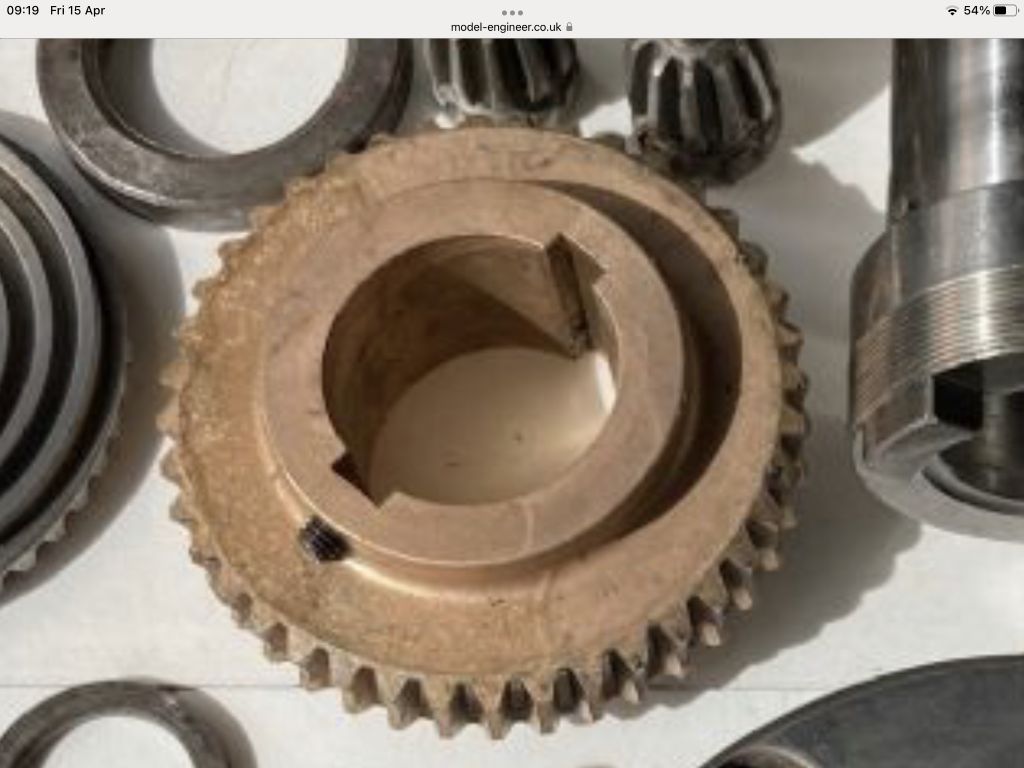Posted by Michael Gilligan on 15/04/2022 06:20:07:
The short-cut, of course, would be to identify the device [which is where we came in].
The short cut, of course of course, is to use the brains with which we are blessed and work this information out for ourselves.
We are asked to ID a dividing head. The only pictures we have of it are in a fully disassembled state. We have no data on the indexing arrangement (i.e. the max. and min. hole PCD that it will accommodate) nor the indexing pin size. We do not do Mystic Meg here, we do engineering.
If identification is our aim, we need photos of the full piece. Supplementary information that also provides a good lead is the worm ratio (you do not need any plates at all to find that), the fasteners used on it (metric UN, Whit), the spindle fitting (e.g. a metric spindle nose thread would point us in a different direction to a Myford spindle nose thread).
John Hinkley provides reasoning for a 90:1 ratio. I tend to agree with him. So we go and look at something that has the same worm ratio (e.g. the HV6 given as an example). If we find any difference between the plates on that and the plate we have, we do not give up, we identify exactly what that difference is and see if it is an equivalence rather than a difference.
Below is the info. for an HV6. It has a 20 hole and an 18 hole. Everything you can do with these, you can do with the 40 and 36 on the plate above. Note that it comes with three plates with six hole circles in each, which may not be a suitable arrangement for the one above if you cannot fit six circles in the range of the indexing arm.
—
90:1 worm ratio
Hole circles=[15,16,17,18,18,19,20,21,23,27,29,31,33,37,39,41,43,47,49]
—
All divisions possible with above plates
[1, 2, 3, 4, 5, 6, 7, 8, 9, 10, 11, 12, 13, 14, 15, 16, 17, 18, 19, 20, 21, 22, 23, 24, 25, 26, 27, 29, 30, 31, 32, 33, 34, 35, 36, 37, 38, 39, 40, 41, 42, 43, 45, 46, 47, 48, 49, 50, 51, 54, 55, 57, 58, 60, 62, 63, 65, 66, 69, 70, 72, 74, 75, 78, 80, 81, 82, 85, 86, 87, 90, 93, 94, 95, 96, 98, 99, 100, 102, 105, 108, 110, 111, 114, 115, 117, 120, 123, 126, 129, 130, 135, 138, 141, 144, 145, 147, 150, 153, 155, 160, 162, 165, 170, 171, 174, 180, 185, 186, 189, 190, 195, 198, 200, 205, 207, 210, 215, 222, 225, 230, 234, 235, 240, 243, 245, 246, 255, 258, 261, 270, 279, 282, 285, 288, 290, 294, 297, 300, 306, 310, 315, 324, 330, 333, 342, 345, 351, 360, 369, 370, 378, 387, 390, 405, 410, 414, 423, 430, 435, 441, 450, 465, 470, 480, 486, 490, 495, 510, 522, 540, 555, 558, 570, 585, 594, 600, 615, 630, 645, 666, 675, 690, 702, 705, 720, 735, 738, 765, 774, 810, 846, 855, 870, 882, 900, 930, 945, 990, 1035, 1110, 1170, 1215, 1230, 1290, 1305, 1350, 1395, 1410, 1440, 1470, 1485, 1530, 1620, 1665, 1710, 1755, 1800, 1845, 1890, 1935, 2070, 2115, 2205, 2430, 2610, 2790, 2970, 3330, 3510, 3690, 3870, 4230, 4410]
—
Missing divisions up to 100
[28, 44, 52, 53, 56, 59, 61, 64, 67, 68, 71, 73, 76, 77, 79, 83, 84, 88, 89, 91, 92, 97]
—
Hole circles needed to produce missing divisions
[14, 22, 26, 53, 28, 59, 61, 32, 67, 34, 71, 73, 38, 77, 79, 83, 14, 44, 89, 91, 46, 97]
 Michael Gilligan.
Michael Gilligan.




